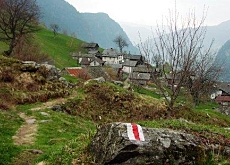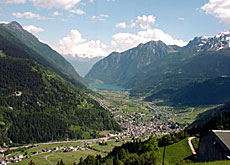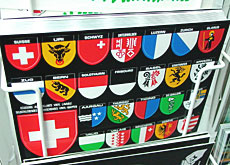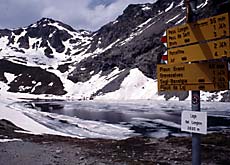Valley dwellers bank on nature for survival

The people of the villages in the Calanca valley are moving ahead with ambitious plans to put the region on the map, instead of heeding calls to abandon it.
The creation of a new national park could secure the survival of the valley’s communities amid calls for their financial lifelines to be cut.
A sign pointing to a small road leading up the mountainside is the only hint of the valley’s existence, and that it might contain human life.
Yet the fate of the 800 residents living in the dozen villages of the Calanca valley came in for nationwide attention late last year when a leading think tank, Avenir Suisse, said the country could no longer afford to subsidise economically weak regions.
The tabloid Blick newspaper used the valley in the southeastern canton of Graubünden as an example of how such areas are a drain on public finances, and asked whether it would not be better to cut off subsidies and let them die.
Maintenance of the valley road and the two cable cars connecting the lower with the upper villages cost taxpayers more than SFr3.5 million ($2.97 million) annually, and another SFr1 million is needed to subsidise the valley’s farmers.
And more than SFr250,000 is spent each year to protect the villages against avalanches, rockslides and flooding.
No return on investment
Footing the bill are the Swiss – most of whom have never seen nor heard of the Calanca valley. And as Avenir Suisse argues, they do not get much of a return on their investment.
Besides a few farms and a rock quarry, there is little industry producing goods or generating tax revenues. The villages have a high proportion of pensioners or residents who commute to work in the towns below.
If anything, the criticism has been a wake-up call.
“No politician will take the demands of the think tank seriously,” says Riccardo Tamoni, who heads a regional promotion organisation. “But the cantonal authorities have asked us to look into ways, possibly by loosening planning and zoning regulations, to encourage economic growth.”
Cultural diversity
Tamoni adds that preservation of the region – one of the few in Graubünden where Italian is the first language – ensures cultural diversity in the only Swiss canton with three official languages (German and Romansh dominate).
He also believes the mountain wilderness on the valley’s doorstep could be better exploited for tourism. To that end, his organisation is spearheading moves to have it declared a national park.
The federal parliament supports the creation of a second national park, and this area bordering the Calanca valley is thought to have a strong chance.
“You just can’t uproot people from their homes,” says Agnese Berta of the Avenir Suisse plan (see video).
A resident of Braggio, Berta runs an organic farm which doubles as a simple but cosy bed and breakfast for hikers, and – as mayor – takes care of the administrative chores of the idyllic car-free village perched 700m above the valley floor.
“I can’t see whole valleys being abandoned. That would be a disaster since a densely populated country like Switzerland needs places like this which are unspoilt yet cared for.”
Revival
She points to the number of renovated old stone and timber farmhouses converted into weekend homes as a sign that the valley is coming back to life.
Great efforts have also been made to restore the valley’s old Baroque churches and chapels listed as heritage sites.
From the 16th century, the valley produced many skilled architects and artists.
Having learned their craft in Milan, they received commissions to build and decorate hundreds of monasteries, opulent residences and imposing fortresses in towns and cities north of the Alps – as far away as Warsaw.
The monuments they erected upon their return are cultural bridges between northern and southern Europe.
Berta says there are distinct advantages for young people growing up in the valley today.
Few distractions
“They have direct contact with nature, and aren’t overwhelmed by all the distractions of modern urban society.”
However, she says when the time comes, they like their forefathers should go out into the world.
“I don’t think it would be right to try to keep them here. I think the challenge facing my generation is to make life attractive so they will return one day,” she says.
“We in this valley have to learn to set goals and to work together to reach those goals. It’s the duty of each and every person to take an interest in how this valley develops, to become aware that we are responsible for our own future.”
swissinfo, Dale Bechtel in the Calanca valley
The Calanca valley is located in southeastern Switzerland.
It belongs to canton Graubünden but is linked by public transport to Bellinzona, the capital of canton Ticino, about 20km from the valley entrance.
Simple bed and breakfast-style accommodation is available in the village of Braggio, one of the two villages set high above the valley floor which is reached by a self-operating cable car.
There is a good network of hiking routes of different lengths at various elevations.

In compliance with the JTI standards
More: SWI swissinfo.ch certified by the Journalism Trust Initiative




You can find an overview of ongoing debates with our journalists here. Please join us!
If you want to start a conversation about a topic raised in this article or want to report factual errors, email us at english@swissinfo.ch.